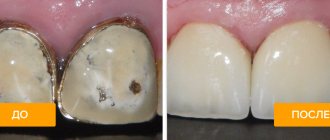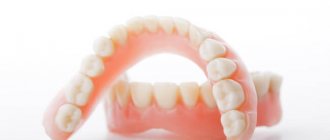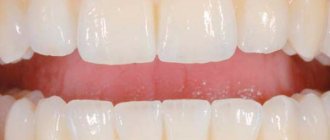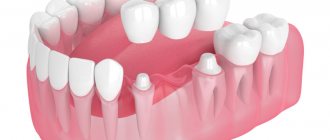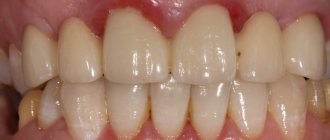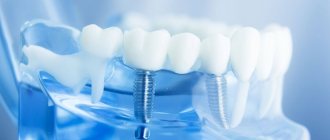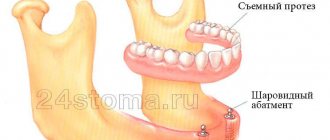We will describe in detail which crowns are best to place on chewing teeth and which on the front teeth. Our specialists have been installing the best crowns at affordable prices for over 25 years.
Many patients, before visiting a specialist, study the types of dental crowns and seek to find out which ones are best suited for each specific situation. Most people rely on forums, others ask their friends questions about the results of prosthetics. Unfortunately, only a few manage to obtain real information.
This article provides comprehensive information regarding the different types of crowns, methods of their manufacture, performance characteristics, service life and pricing policy. We hope that while reading this material you will study in detail the types of crowns on teeth and be able to understand which ones are best suited for a particular area of the jaw.
For everyone who does not know where it is best to put crowns on their teeth , we offer services of the highest level. In our clinic, all procedures are carried out under the guidance of specialists with impressive experience and deep knowledge in the field of prosthetics. In addition, we focus on using only modern durable materials, high-precision dental equipment, and implement effective technological solutions. This allows each patient to count on high-quality and long-lasting treatment results.
Types of Best Dental Crowns for 2022
Modern dentistry offers patients crowns made from various materials. It is this indicator that is key in determining the cost, quality parameters and indications for the use of a particular prosthesis. Another important criterion on which the quality of a product depends is the production method.
The following crowns are currently in demand:
- Metal-ceramic. They are among the most popular prosthetic devices. Includes a metal base and an outer facing layer of ceramics. Initially, the frame is made, after which the ceramic coating is performed. The production process can be carried out on the basis of modern computer programs and aesthetic modeling.
- All-ceramic. In the manufacture of such prostheses, metal-free ceramics are used. Provides maximum safety in relation to soft tissues, which is due to the biological inertness of this material. The manufacturing process is based on the firing technique; ceramic pressing technologies; use of milling equipment and modern digital programs.
- Crowns made of zirconium material. Despite its origin (metal), zirconium dioxide is famous for its unrivaled aesthetics and increased safety. The manufacturing process is based on the use of specialized digital programs and milling equipment. Two versions of such prostheses can be used: combined (include a base of zirconium material and ceramic lining) and monolithic (made of zirconium oxide without the use of a ceramic coating).
- Glass ceramics e.max. It is distinguished by perfect aesthetic parameters and the necessary strength. There are currently 2 material options in use: E.max RPESS - produced by injection molding using elevated pressure and temperature conditions, and E-max CAD - produced using modern digital applications and milling machines (CAD/CAM concept).
Restoration of ceramic crowns
Despite the strength of modern ceramic dentures, the query “The ceramic has broken off from the crown, what should I do?” found on the Internet quite often. Typically a defect occurs for the following reasons:
- injury - blow or fall;
- defects in the work of a dental technician;
- malocclusion, bruxism;
- strong mechanical impact on the structure during chewing.
There are two possible solutions to the problem - replacement and restoration.
- Replacement of prosthesis. The crown is removed from the mouth, and the entire prosthetic process is repeated from the moment the impressions are taken until the new structure is attached.
- Restoration. The chip on the ceramic crown is polished to the optimal shape, and a light-curing composite material is placed into the cavity. After hardening, the specialist models the coating, forms bumps and fissures, and grinds uneven edges to the desired size.
The advantages of repair are short time and low cost; chipped ceramics on the crown can be restored in an hour in the dentist’s chair. However, even the use of the most modern materials does not provide the quality that is obtained when making a prosthesis “from scratch” in a dental laboratory. If the cause of the chip was carelessness when chewing hard food, after repair the denture will last for many years. Malocclusions and other pathologies of the dental system reduce the service life of the restored crown several times.
Comparative characteristics of the best crowns
To determine which crowns are the best , you need to study the pros and cons of each product, taking into account the material used.
Next, we will compare the key parameters of various prosthetic options:
| Crown | pros | Minuses |
| Made from metal-ceramics using precious metals | Has increased strength, has a natural appearance, does not cause allergization of the body | High price |
| Made from metal-ceramics using non-precious metals | It is famous for its sufficient strength, has a reasonable price and good aesthetic parameters | There is a possibility of allergy |
| Made of ceramic material | Features impeccable aesthetic parameters and absolute compatibility with the patient’s body | Increased fragility |
| Made of zirconium material | Excellent aesthetic properties, long period of operation, absolute compatibility with the body, absence of allergic reactions | Impressive value |
| e.max crowns | Unsurpassed aesthetics, increased strength, excellent light transmittance. Emax Press has a gradient of color and transparency. | High price. Only single crowns can be installed in the chewing region. |
What are the best crowns for chewing teeth?
In general, the controversial issue regarding which crown is best to place on chewing teeth may have a completely unambiguous solution. Since this department experiences increased chewing pressure, it is advisable to use high-strength and most reliable prostheses to recreate the missing units. However, despite the need to restore functional characteristics in this area, the aesthetic component should not be ignored. Moreover, making the right choice is also important from the standpoint of the biocompatibility of the material.
Next, you will get acquainted with detailed information regarding which crown is best to place on the chewing teeth, taking into account the material used:
- Metal ceramics . According to statistics, this material is among the most popular in orthopedic practice. First of all, this is due to the excellent quality and affordable prices for such crowns. As for the negative aspects, they include a significant likelihood of chipping, unlike traditional analogues. In addition, there is a risk of cyanosis appearing at the border of the gum and the prosthetic device, which has an undesirable effect on aesthetics;
- Dentures made of ceramic material . The possibility of using such crowns depends on their type. It is undesirable to fix standard ceramic structures in the masticatory region due to their significant fragility and increased likelihood of breakage. However, at the moment it has been possible to develop more durable crowns that make it possible to recreate the missing units in any area of the jaw. These include Emax and Empress glass-ceramic structures. But if you study dental crowns from the point of view of which ones are better, the price in this case is not a priority criterion (over 20,000 rubles per unit);
- Structures made of zirconium material . They allow you to recreate the missing units in the lateral section, since they are considered the most highly durable and durable prostheses. It is recommended to use monolithic crowns, which eliminates the possibility of using a porcelain coating and, as a result, minimizes the possibility of chipping. However, the price of such a prosthetic device can be higher than 30 thousand rubles;
- Emax crowns . Despite the exceptional aesthetics and excellent strength parameters (up to 400 MPa), such crowns are best used for the frontal area. For the chewing region, it is allowed to use single crowns made of E-max RPESS material obtained by pressing.
Attending doctors at the Elident clinic
Mlodik Boris Naumovich
Dental surgeon, implantologist, orthopedist
Clinical experience : 26 years
Vakhrushev Alexander Viktorovich
Dental surgeon, implantologist, orthopedist
Clinical experience : 25 years
Metal-ceramic crowns for front teeth
The basis for this design is a metal base with a thickness of 0.5 millimeters. To obtain the material for such prostheses, a combination of chromium and cobalt is used, but sometimes you can find products made from precious alloys. In laboratory conditions, to create such crowns, they resort to the method of layer-by-layer application of ceramic material onto a metal frame. To ensure maximum strength and solidity of the structure, the ceramic mass is fired under high temperature conditions.
An aesthetic disadvantage of the above orthopedic products is the presence of a metal base under the ceramic layer. Moreover, the porcelain material used must be opaque to eliminate the possibility of it showing through the metal.
However, the light transmittance of dentin and enamel should be taken into account, which makes the outermost part of the tooth transparent in bright light. This indicates the inadmissibility of installing metal-ceramic structures for people with increased enamel transparency. The best option for using such crowns would be for patients with low levels of transparency. But it must be borne in mind that in strong lighting, differences in shade and light transmission may still be visible.
So, crowns for the front teeth made of metal-ceramics, as evidenced by reviews, have the following positive characteristics:
- Acceptable aesthetic indicators;
- Affordable price;
- High structural strength.
The disadvantages of such structures include:
- Negative effects on natural teeth;
- The likelihood of allergic reactions to metal material;
- Risk of cyanosis near the gingival margin.
Metal-ceramic crown »
Ceramic crowns for front teeth
These metal-free crowns for the front teeth are considered indispensable when restoring teeth in the frontal area. They allow you to eliminate some of the aesthetic shortcomings of natural enamel, which include excessive abrasion, developmental pathologies and massive surface damage. In addition, all-ceramic designs are ideal for individuals with a high likelihood of allergic reactions to metal alloys. However, they are not installed in the area of chewing teeth, due to their increased fragility.
The ideal option is to fix such crowns within 1-2 lost units. Bridge crowns made of this material are not installed on the front teeth.
However, today, due to the active use of innovative technologies, you can find dentures made of ultra-strong ceramic material, suitable for recreating any lost tooth. Unfortunately, the cost of such a design will exceed the prices for classic products made from solid ceramics.
So, the “advantages” of the products presented above include:
- Impeccable aesthetic indicators;
- Full compatibility with the human body;
- Absolute identity with natural analogues.
Among the disadvantages of metal-free structures are:
- Insufficient strength;
- Overpriced.
Ceramic crowns for teeth »
Zirconium crowns for front teeth
Zirconium crowns for the front teeth are among the most durable and aesthetically perfect modern designs. Due to the use of zirconium material in their manufacture, it is possible to achieve high reliability indicators characteristic of metal and obtain prostheses with good hypoallergenic qualities.
Ceramic crowns for the front teeth, made on the basis of this material, do not have a metal base, which provides excellent aesthetic parameters. But their main advantage is still increased strength.
It should be noted that, despite the positive characteristics presented, some patients express dissatisfaction with the installed zirconium crowns. This is due, first of all, to the rather low light transmittance. That is, the difference between the transparency of natural enamel and the prosthesis material can also be traced here.
This means that it is better to install these designs in patients with slight transparency of natural enamel, which will provide a completely harmonious aesthetic effect.
However, at the present stage of development of dentistry, there is an improvement in the properties of zirconium crowns. Many manufacturers have taken a course towards creating blocks with higher levels of transparency and pre-painted products with a gradient. This made it possible to develop orthopedic structures that are completely identical to natural teeth.
Thus, zirconium dioxide prostheses are famous for the following advantages:
- Acceptable aesthetics;
- Increased reliability indicators.
The disadvantages of such products include:
- Lack of transparency corresponding to natural enamel;
- Zirconium crowns for front teeth are overpriced.
Zirconium crowns »
Ceramics on a zirconium frame
If you are interested in the question: “Which crowns are best to put on the upper front teeth?”, this option is certainly a winner. Such prostheses are ideal for those patients who dream of ultra-strong structures with excellent aesthetic parameters.
Unlike metal-ceramic prostheses with low aesthetic properties, zirconium-based crowns combine high aesthetic properties and the necessary strength.
Such crowns for the front teeth made of zirconium, as confirmed by reviews, are used not only in the process of single prosthetics, but are also excellent for the manufacture of bridge structures. At the same time, increased strength is achieved through the use of computerized technologies and milling methods.
So, some of the positive aspects when using these products include:
- Ideal aesthetics;
- Excellent reliability indicators.
Negative sides:
- Overcharge.
An alternative to crowns for chewing teeth
It should be remembered that even in the presence of significant damage, a tooth can be restored using a conventional light-composite filling and pin. If it is necessary to eliminate a single defect, implant fixation is recommended.
Which is preferable: a filling, a pin or a crown?
As mentioned earlier, with significant destruction of the coronal part of the tooth (more than 50%), it is possible to recreate it using a light-composite filling mass. In this case, a pin made of fiberglass or metal material is used, which allows for more reliable fixation of such a filling.
If the tooth crown is destroyed by more than 50%, experts recommend resorting to the use of a prosthesis. This primarily applies to units from which the pulp has been removed, as these are considered the most fragile.
Also, in case of significant destruction of the coronal part, dentists use a special stump insert, which ensures a more durable installation of the prosthesis.
What to choose: a crown or a dental implant?
When considering the replacement of missing units with crowns, implant fixation is the preferred option for eliminating a single defect. When using a dental structure, the need to prepare teeth that act as supporting elements is eliminated. In addition, implants have a longer period of use, in contrast to single prosthetic structures and bridges.
Reviews from doctors and patients
Dentists consider dentures with crowns to be an excellent way to restore significantly damaged elements. Doctors note a significant advantage of this solution - it is an opportunity to prevent the destruction of a “dead” tooth or even preserve a “living” unit (if it is partially destroyed). This method cannot be called universal only because it has a number of contraindications, one of which is root damage.
Patients, for the most part, speak positively about prostheses of this type. They note the rapid restoration of functionality and aesthetics of the series, ease of use and durability of the prostheses.
What are the best crowns for front teeth?
When we are trying to figure out how to choose the best crowns for the front teeth, the priority criterion is the aesthetic component. At the same time, prosthetic structures intended for the frontal region must have a natural appearance, fully correspond to natural analogues and have sufficient strength. However, when you plan to fix a crown on the front teeth, there is no point in asking: “Which dentures are better to install on the lower jaw, and which ones on the opposite side?”
In both cases, the same type of prosthetic device models are used. Below we will provide more selected information:
- Metal-ceramic crowns . Despite the reasonable cost, this is not a completely suitable option in terms of aesthetic parameters. Firstly, an undesirable bluish tint appears in the area where the prosthesis adheres to the gum. Secondly, the metal base can be viewed through the ceramic coating. Of course, today there are improved designs with shoulder mass, but their price will significantly exceed the cost of a standard crown;
- Dentures made of ceramic material . This is the most advantageous option in cases where a dilemma arises as to which crowns are best placed in the frontal part of the jaw. Moreover, for this department you can resort to the help of traditional prostheses made of all-ceramic material. Their cost is considered affordable for most patients;
- Zirconium crowns . This solution is considered one of the most expensive when it is necessary to reproduce anterior teeth. However, this option is considered preferable for those who want to find out which crowns are best to put on their front teeth, but for whom pricing policy does not matter;
- Emax crowns . Such designs are made from an improved material - glass ceramics, which has excellent aesthetics. In this case, it is advisable to choose the E-max RPESS Multi material, which has a gradient of color and transparency, which will allow you to recreate the lost frontal units with maximum identity.
Our clinics
Clinic "Elident" on Varshavskaya
Varshavskoe highway, 75, bldg. 1, Moscow 117556
- Varshavskaya (500 m, closed until 2021)
- Nakhimovsky Prospekt (1,300 m)
Mon-Sat : 09:00-21:00; Sun : 09:00-19:00.
Online registration
+7 (495) 649-41-19
Elident Clinic in Annino
Varshavskoe highway, 154, building 1, Moscow 117405
- Annino (500 m)
- Academician Yangelya (700 m)
Mon-Sat : 09:00-21:00; Sun : 09:00-19:00.
Online registration
+7 (495) 649-41-19
Alternative options to frontal crowns
At the moment, there are three alternative methods that allow you to restore the crown part of the tooth, with destruction of no more than 50%. These include:
- Veneers. Suitable for use if there is slight destruction of the outer surface of one of the front teeth. An important requirement for carrying out a procedure using such plates is the preservation of the tooth wall from the inside. Through veneers, unsurpassed aesthetics are achieved, the possibility of tooth preservation is ensured and it is possible to significantly extend the life of the tooth;
- Dental implants. If it is necessary to reconstruct 1-2 teeth and install bridge-like prosthetic devices, it is advisable to fix the implants instead of preparing the supporting units;
- Filling material. As mentioned earlier, the option with light-composite restorations is preferable when the coronal part of the tooth is destroyed by no more than 50%.
Indications for prosthetics
- Chipped crown (when the defect cannot be corrected by installing a filling);
- multiple cracks in the enamel;
- pathological abrasion of enamel;
- fluorosis;
- tetracycline teeth;
- color change (darkening, yellowing);
- destruction of the supragingival part of the tooth more than 70% with preservation of the root;
- thin, weakened enamel;
- replacement of an old restoration.
What crowns are best to put on implants?
When studying the question of which crowns are best placed on implants, one should remember the classic procedure for installing dentures. If it is necessary to recreate the missing units in the frontal region, experts give preference to the aesthetic component. The best dental crowns in this situation will be made from zirconium material or ceramic.
If you need to fix crowns on your chewing teeth, and you don’t know which ones are better, any experienced dentist will give clear advice - in this area it is advisable to install prosthetic devices made of metal ceramics, zirconium material or e.max glass ceramics. It should also be taken into account that adapters in dental structures, in the event of subsequent use of the above prostheses, must be obtained from materials that are unable to be seen through the ceramic layer.
Many patients are interested in which crowns are better, ceramic or zirconium, to be fixed to implants? According to leading experts, the most advantageous options include devices made from the innovative material E-max or zirconium dioxide.
Additionally, when evaluating whether metal-ceramic or zirconia crowns are better, it is important to consider the need for zirconia adapters. This will prevent the body from becoming allergic to metal, as well as obtain the desired aesthetic result.
Stages of prosthetics
- Preparation
- assess the general condition of the oral cavity, take an x-ray, carry out hygienic cleaning (removal of plaque, tartar), treat caries, gums, change old fillings. - Preparation
- the front tooth is ground down for a crown, the stump is given the desired shape. According to indications, depulpation, treatment, and filling of dental canals are carried out. In case of severe destruction of the supragingival part, the root is strengthened with a stump insert. The prepared support is covered with a temporary plastic structure to protect tissues from destruction, chemical and temperature irritants. - Taking impressions
– the doctor takes impressions of the patient’s teeth using an impression tray with impression material or a digital scanner. The obtained data is transmitted to the dental laboratory. - Making a crown
- based on models, an orthopedic system is created in the laboratory using casting, pressing, and milling. At the manufacturing stage, the model is tried on the patient, and adjustments are made if necessary. - Installation
- the finished crown is fixed to the support with dental cement. The crown on the front tooth implant is installed using a cement or screw method.
Prices for tooth crowns at Elident
When assessing dental crowns from the standpoint of which ones are better financially, one should take into account the material used, the technological solutions being implemented, the equipment used, as well as the level of professionalism of the specialist and the rating of the dental institution in which the teeth are restored.
The Elident clinic has affordable prices for all types of services related to the fixation of implants and the installation of dental crowns. At the same time, you can always count on an individual attitude and high professional training of dentists, which is combined with the use of highly effective innovative equipment and modern prosthetic concepts.
| Service | Price, ₽. |
| Consultation with an orthopedist | for free |
| Orthopantomogram - panoramic image of teeth | 950 |
| Ceramic crown Dutseram plus (Germany) | 20 500 |
| Ceramic crown made of zirconium dioxide | 32 000 23 000 |
| Empress crown | 19 000 |
| Ceramic crown made of zirconium dioxide on an implant | 35 000 |
| Temporary plastic crown/wedge. | 1700/1200 |
| Taking an impression from alginate mass | 300 |
| Diagnostic plaster model | 300 |
| Taking a double impression | 800 |
| Cementing inlays and crowns using Fuji cement | 700 |
| Cementing inlays and crowns using Fuji+ cement | 800 |
| Temporary cementation of one crown | 400 |
| Removing one crown with stamped sawing | 500 |
| Removing one crown with sawing the cast | 1 000 |
| Removing one crown with sawing MK | 800 |
Free consultation
Our specialists will conduct a free consultation and select the best treatment option for you.
Sign up now! Online registration
+7 (495) 649-41-19
e.max crowns on front teeth
When considering crowns for the front teeth, we strive to give a clear answer as to which ones are better aesthetically and functionally. The undisputed leader in this direction is Emax glass ceramics. This is an improved modern material, the creation of which is based on the use of lithium disilicate, which has impeccable characteristics. Emax ceramic crowns look perfect on the front teeth because they have light transmission that fully matches natural enamel. The same can be said about veneers made from the above material; they are completely indistinguishable from natural teeth
Today there are 2 known options for Emax materials:
- E.maxPRESS. Widely used to obtain dentures and veneers. This involves the injection molding method under the influence of pressure and high temperature conditions. Such crowns are indispensable when restoring single teeth or creating short bridge structures.
- E.maxCAD. In the production of this material, modern computer technologies and computer-controlled machines are used. Such crowns are characterized by less high reliability, which eliminates the possibility of creating bridge structures and ultra-thin veneers. Also among the disadvantages of E.maxCAD is the limited selection of shades, which reduces the chances of obtaining a design identical in color to natural enamel.
Service life of dental crowns
If you are interested in a tooth crown and what material is best for its manufacture, an important point is the service life of the product. For example, prosthetic devices made of metal-ceramics can be used for 8-10 years, zirconium structures - over 15-20 years, glass-ceramic products - over 15 years.
However, when studying the properties of dental crowns and trying to find out which ones are better suited for prosthetics in a particular area of the jaw, one should not forget about compliance with the patient’s care requirements and the quality of the procedure performed by the dentist.
Under normal conditions, assuming proper training of the doctor and strict compliance with the production concept, the service life of crowns cannot be less than 10 years.
Caring for tooth crowns
When studying the topic of dental crowns and trying to understand which ones are better, many rely on reviews from other patients and specialists. At the same time, any qualified doctor will tell you that to extend the life of a prosthetic device, you first need to pay attention to the rules of care.
For example, if you have a single crown installed, it is enough to carry out regular hygiene procedures using toothpaste, brush and dental floss. In the presence of bridge structures, as well as in patients with periodontal pockets in the area of dentures, it is necessary to resort to the help of irrigators. These devices help clean hard-to-reach areas from dental plaque and food debris.
Article expert (author):

